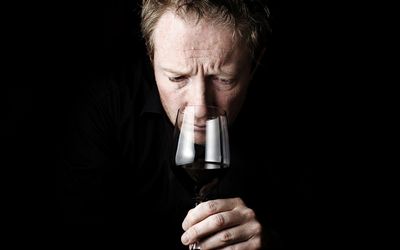SOMMELIERS are a relatively new feature of the food-and-wine scene in SA. Not so long ago, the Cape Wine Academy offered a "Cape Sommelier" qualification (little more than a glorified wine waiter course), convinced that no one would notice or care. Explaining that a fully qualified sommelier undergoes years of rigorous training, while gaining service experience made no impression on the academy’s management. In their view, the preface "Cape" authorised a boundless dilution of the international requirements because "it was at least a step in the right direction".
The Saxon in Johannesburg was one of the first venues that recognised the value of properly trained wine service staff. More than any other establishment, including the much-fêted Cape Town restaurants, it has created an environment that provides appropriate on-the-job training.
Those who have passed through its portals now occupy suitably elevated positions around the country, while one of their original group, Gareth Ferreira (resident in London after a stint in Dubai), finished in the top 15 at the 2016 world sommelier awards.
At a recent function organised by the Webb family of Thelema to present a vertical line-up of the estate’s Rabelais red blend, I was chatting to several local somms. I realised their presence provided evidence of the much-improved status of sommeliers. If they really were simply wine waiters, they would never have cracked the nod.
Moreover, as a result of this exposure, their view of what should be offered to their wine-literate customers has also evolved. They have become not merely more critical but, happily, more cynical when it comes to filtering puffery from the producers.
Despite the value they add to the establishments wise enough to pay (the not-substantial) premium to employ them, they all report on the limited number of job opportunities.
It is not difficult to work out why: a terrifying number of restaurants and hotels are happy to have their suppliers prepare their wine lists for them and to take the kick-backs (some running to more than R100,000 annually) offered in the form of listing fees. These proprietors have taken the view their customers will find something to drink from the wine list (no matter how boring) and the real value of being a licensed establishment resides in the upfront cash payment. Under these circumstances, they reason, there is no need to employ a specialist to manage the wine service.
Sommeliers seek out the more interesting wines — often less showy, and almost always from the small, less industrialised cellars. They have to "talk" the wines onto the tables — which means listening to what the customers like to drink, and matching their expectations with what is on the menu and in the cellar. It is easy to see why Thelema wanted to show Johannesburg’s sommeliers how the Rabelais blend has evolved from the days when Gyles Webb took it from being one of the top-selling Cape Winemakers Guild wines available only on auction to the cellar’s premium red.
While the first vintage was a cabernet-merlot blend, over the years, petit verdot has replaced the merlot. The maiden 2007 was solid enough, the 2008 excellent (especially considering the vintage) the 2009 superb, the 2010 even more impressive, while the 2011 and the 2012 are almost too youthful to be considered in the same line-up.
It is exactly the point of hosting a vertical tasting: a producer needs to show where a wine has come from, and where it is likely to go. In the case of the Rabelais, it is not sufficient to track how the merlot has been supplanted by petit verdot.
The people who invest in it in anticipation of that moment when it is ready to walk down the aisle need some assurance the creature in swaddling is destined to be a comely bride, or a handsome groom.

Sommelier. Picture: ISTOCK
SOMMELIERS are a relatively new feature of the food-and-wine scene in SA. Not so long ago, the Cape Wine Academy offered a "Cape Sommelier" qualification (little more than a glorified wine waiter course), convinced that no one would notice or care. Explaining that a fully qualified sommelier undergoes years of rigorous training, while gaining service experience made no impression on the academy’s management. In their view, the preface "Cape" authorised a boundless dilution of the international requirements because "it was at least a step in the right direction".
The Saxon in Johannesburg was one of the first venues that recognised the value of properly trained wine service staff. More than any other establishment, including the much-fêted Cape Town restaurants, it has created an environment that provides appropriate on-the-job training.
Those who have passed through its portals now occupy suitably elevated positions around the country, while one of their original group, Gareth Ferreira (resident in London after a stint in Dubai), finished in the top 15 at the 2016 world sommelier awards.
At a recent function organised by the Webb family of Thelema to present a vertical line-up of the estate’s Rabelais red blend, I was chatting to several local somms. I realised their presence provided evidence of the much-improved status of sommeliers. If they really were simply wine waiters, they would never have cracked the nod.
Moreover, as a result of this exposure, their view of what should be offered to their wine-literate customers has also evolved. They have become not merely more critical but, happily, more cynical when it comes to filtering puffery from the producers.
Despite the value they add to the establishments wise enough to pay (the not-substantial) premium to employ them, they all report on the limited number of job opportunities.
It is not difficult to work out why: a terrifying number of restaurants and hotels are happy to have their suppliers prepare their wine lists for them and to take the kick-backs (some running to more than R100,000 annually) offered in the form of listing fees. These proprietors have taken the view their customers will find something to drink from the wine list (no matter how boring) and the real value of being a licensed establishment resides in the upfront cash payment. Under these circumstances, they reason, there is no need to employ a specialist to manage the wine service.
Sommeliers seek out the more interesting wines — often less showy, and almost always from the small, less industrialised cellars. They have to "talk" the wines onto the tables — which means listening to what the customers like to drink, and matching their expectations with what is on the menu and in the cellar. It is easy to see why Thelema wanted to show Johannesburg’s sommeliers how the Rabelais blend has evolved from the days when Gyles Webb took it from being one of the top-selling Cape Winemakers Guild wines available only on auction to the cellar’s premium red.
While the first vintage was a cabernet-merlot blend, over the years, petit verdot has replaced the merlot. The maiden 2007 was solid enough, the 2008 excellent (especially considering the vintage) the 2009 superb, the 2010 even more impressive, while the 2011 and the 2012 are almost too youthful to be considered in the same line-up.
It is exactly the point of hosting a vertical tasting: a producer needs to show where a wine has come from, and where it is likely to go. In the case of the Rabelais, it is not sufficient to track how the merlot has been supplanted by petit verdot.
The people who invest in it in anticipation of that moment when it is ready to walk down the aisle need some assurance the creature in swaddling is destined to be a comely bride, or a handsome groom.

















